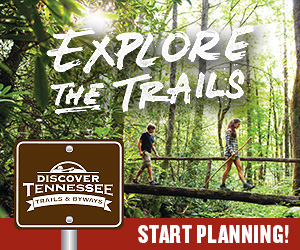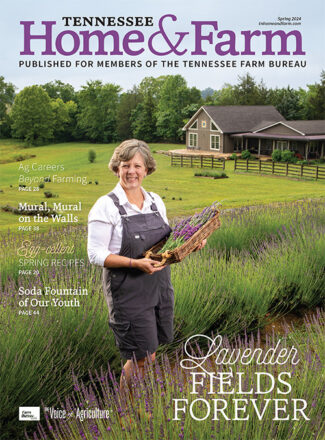A Feel for the Game
Editor’s Note: United States Blind Golf Association national champion and a long-time golf competitor, David Meador was inducted into the Tennessee Golf Foundation Hall of Fame on September 21, 2011. After losing his sight at the age of 18 in a car accident, Meador picked his golf clubs back up and continued to make a name for himself in the golf world. He won his national championship title in 1977.
Meador remains a golf competitor, motivational speaker and is the in-coming president of the U.S. Blind Golf Association. The 67th annual National Championship was played in late August and included players from eight countries around the world. To keep up with the International Blind Golf Championships, visit the organization’s Facebook page.
The following story was written by Tennessee Home & Farm in 2005.

The air is carrot-snap crisp this morning. Though the sun’s out and brilliant, there’s a hint of chill in the air. A benevolent mid-October high-pressure system banishes all clouds, save the highest wispy layer. Old Natchez Country Club splays out in a lazy rolling manner, the slave wall along hole No. 3 coated with a sheen of dew.
Greens and fairways are groomed for the day’s tournament, and eager, nervous golfers line up side by side at the driving range. The incessant tink, tink, tink of practice shots fills the quiet morning air.
David Meador of Nashville ambles a bit uneasily to the driving range, tees the ball high and reaches for his weapon of choice, a Cobra large-head driver. He readies himself: square with the ball, slightly open stance, shoulders even, arms relaxed, grip firm but not tight. He takes a deep breath, and pulls the club head back, painting an easy fluid arc.
Pulling the club head through its graceful descent, Meador finds the sweet spot and, with a sharp metallic ping, sends the ball racing in a straight line right down the middle. A small huddle of golfers watches in awe. “I wish I could hit the ball that consistently,” one says. “How’s he do that?” another asks.
With a respectable handicap and a long list of credentials, David Meador is no average golfer. He’s racked up one national championship and three holes-in-one in the past 25 years, not average by a long shot. Still, Meador jokes, “I have multiple handicaps.”
Meador’s second handicap? He can’t see a thing.
“When I was 18, I was out too late one night in a car that was going too fast,” Meador explains. “I was a passenger, and we simply ran out of road.” The end of the road left him crushed into the dashboard.
With reconstructive surgery, weeks in the hospital and a lifetime ahead of him, Meador remembers thinking that his problem wasn’t crushed bones, but an inability to see. After weeks of tests, the doctor finally made a grim diagnosis: David was told that he would never see again.
Such news would devastate anyone, but Meador is no average human being. Just three months after his accident, his dad “insisted that we get the golf clubs back out.” Meador, an athletic young man, used to play on the high school golf team, but, he says, still recovering from his accident and learning to deal with a lack of sight, “I was in no mood for golf.”
His dad, a man Meador describes as hotheaded, wouldn’t take no for an answer. Together, they drove to a little hometown nine-hole course. “I’m telling you,” Meador says, “standing on this golf course, the wind was blowing in my face … the birds … the trees … it was almost like seeing.”
His description clear and vivid, Meador recalls his dad pulling out a club and lining him up. “That first shot was a beautiful 7-iron, right down the middle about 130 yards,” he remembers. For Meador, that shot exploded into what he calls his “distant future.”
“Honest to God,” he says, “my whole world opened up. Emotionally I understood that if a blind person can play golf and hit the ball like that, a blind person can do anything.”
At 56, Meador has spent 38 years without the gift of sight. But, he says, “I have been given such a nice gift to accept blindness. I’m sort of built for it … athletic, good agility.” His attitude is infectious and spreads easily.
It’s also an attitude that led his life in a new direction about six years ago. After 20 years in the insurance business in Nashville, Meador realized that the increasingly complicated world of investments and insurance was becoming a hurdle to his livelihood.
“I was not doing that well,” he says. “I was holding my own, but treading a lot of water. Financially, I knew we had to do something different.”
Meador and his wife, Connie – whom he met in Chicago while finishing up an undergraduate degree from Southern Illinois University – decided they needed to make a change. Although their two daughters were grown, the couple still needed an income. Meador penned a letter of resignation from Northwest Mutual Life, his employer for the past 20 years.
But leaving wasn’t that easy. “The managing director would not accept my resignation,” Meador says. “He put me in a public relations role and had me give speeches.” Gradually, Meador gained confidence as a public speaker and has now built up a business as a motivational speaker.
“It’s small potatoes,” Meador says.
“One to two speaking engagements a month.” But as a blind golfer and a two-time cancer survivor – something “I don’t like to emphasize,” Meador says – he’s a natural. His motivational routine involves a golf club, a bar stool and a flip chart.
Meador walks onstage, takes out a marker, writes what he calls “gibberish” on the page and says, “Can everybody see that?” Tension is palpable, he says. The crowd never knows what to expect. That tension, he says, “allows people to break out in laughter.”
And the laughs – the breaking down of barriers and reservations – are important to him. “Last time I spoke it was a 45-minute talk. I counted 37 laughs. Not bad,” he says. “Almost a laugh a minute.”
To watch a blind man golf is astonishing. To watch him hold a crowd of people in the palm of his hand, well … that’s nothing short of fun.
Meador says life is like a golf swing. “The back swing is the past, the follow-through is the future, but right here in the middle,” he emphasizes, “right here in the middle, where time flies by in seconds, we have the opportunity to make decisions.”
David Meador made a decision as a young man. When he learned he would never see again, he decided to look to the future, live his life and be “thankful for the gifts I receive.”
In the cool morning air, just before the shotgun start of the Angels Blind Golf tournament at Old Natchez Country Club in Franklin, David Meador tees up another ball and blasts it right down the middle. The crowd of golfers – sighted golfers – has grown. One says, “I’ve got no excuse now. A blind guy just out-drove me by 50 yards.”
Meador turns to the gathering of bemused golfers and says, “Now there is a limit. Sometimes I shank it.”
Interested in Learning More?
The United States Blind Golfers Association was founded in 1953 by Bob Allman of Philadelphia. Allman was responding to the growing number of blind golfers coming out of the Veterans Administration’s golf-as-therapy program for blind vets. Since then, the organization has grown to nearly 100 members nationwide.
Tennessee has a strong connection to blind golf. The 08winter president of the USBGA is Nashvillian Jim Baker; David Meador, profiled in this article, won the USBGA national championship in 1976. The Tennessee School for the Blind also is active in the organization, holding youth division training and competitions.
For information about the USBGA, visit www.blindgolf.com, or call president Baker at 615-885-2952.
How Is It Played?
Blind golf is a team sport – player and coach.
The player has to pick his own club, make the swing unassisted, and basically play the game by USGA rules. There are obvious complications in this arrangement.
If you can’t see how far it is to the hole, you can’t pick a club. If you can’t see the ball, you can’t swing at it. Simply walking back to the cart after a shot becomes impossible if you can’t see a thing.
Enter the coach. The coach’s job is to site the distance. Then the player has to choose his or her own club. (Better get that distance right, coach.)
Next, the coach lines the player up using the club as a guide. Finally, the coach places the club head directly behind the ball.
That’s it. The rest is up to the golfer.












Leave a Comment